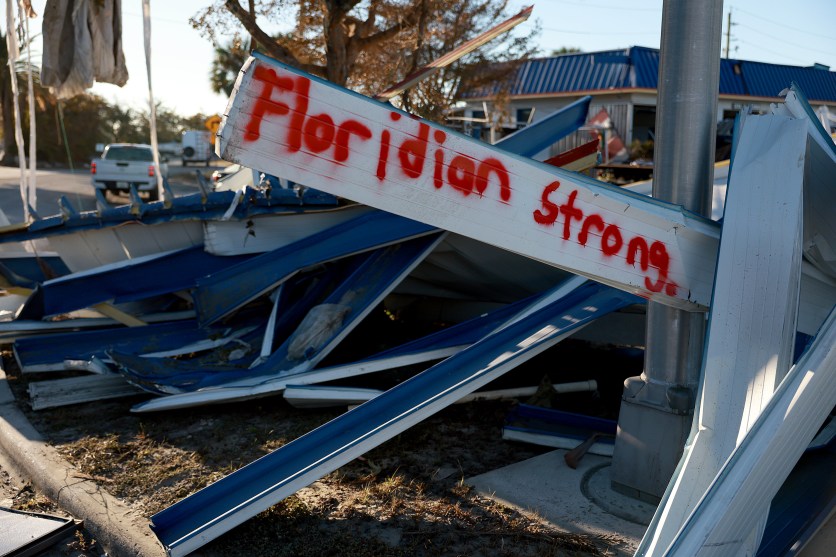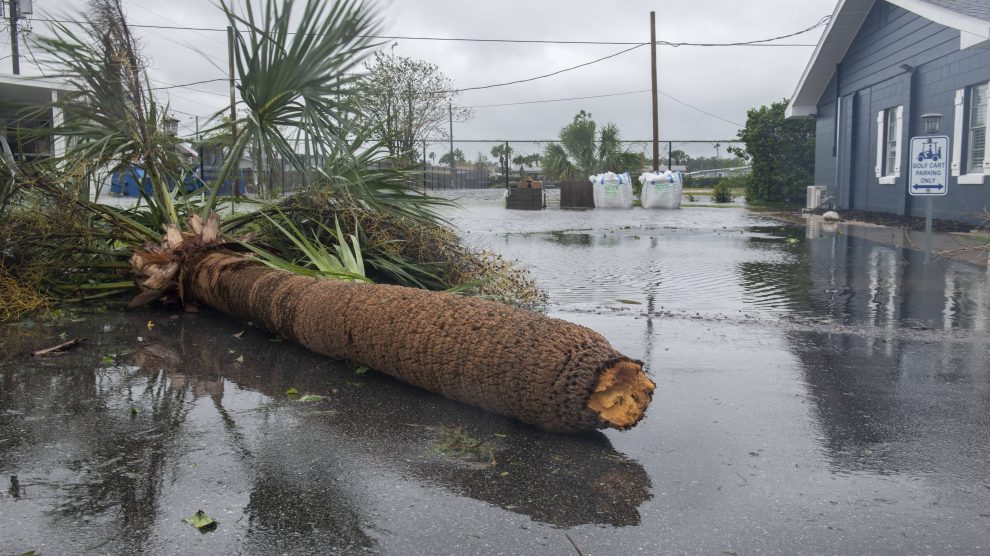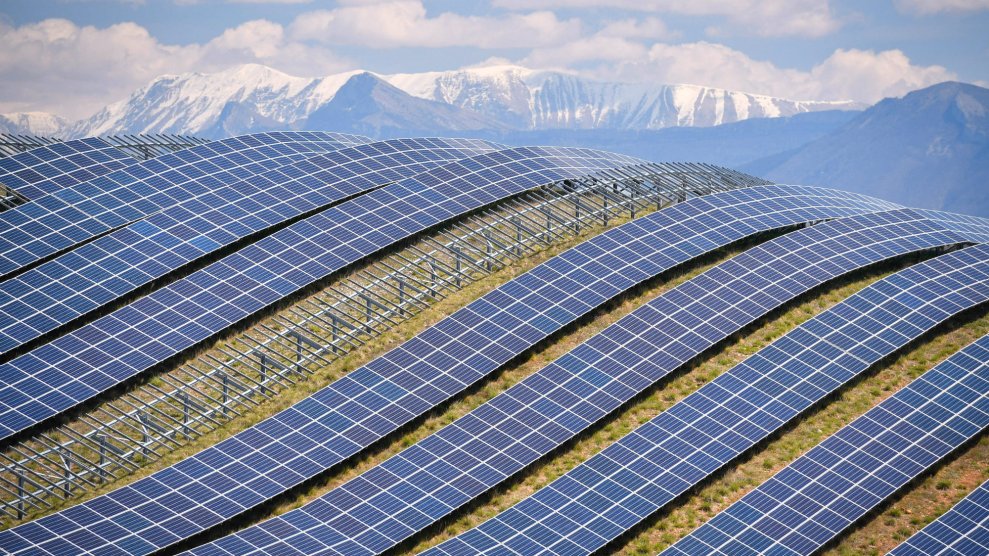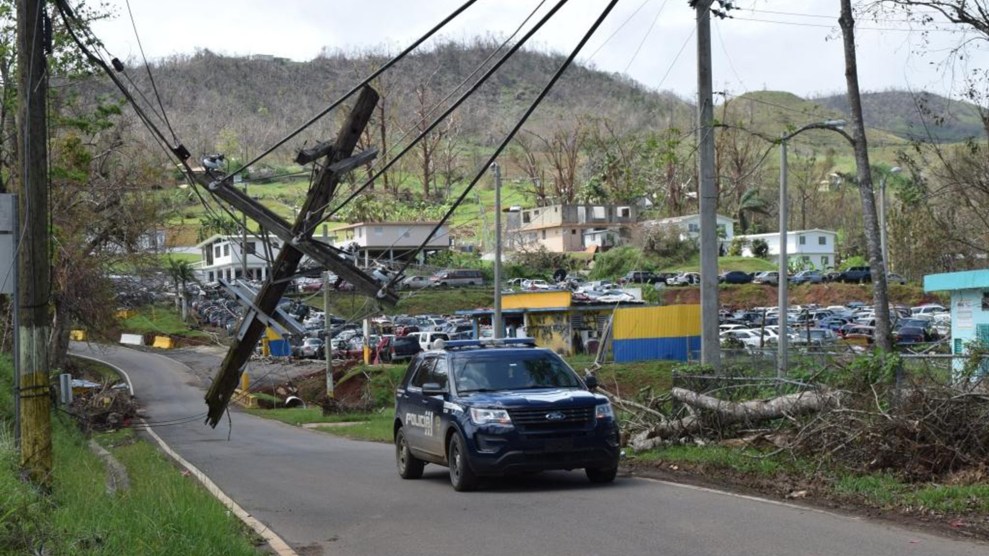
A spray painted sign reads "Floridian Strong" among debris in the wake of Hurricane Ian.Photo by Joe Raedle / Getty
This story was originally published by Slate and is reproduced here as part of the Climate Desk collaboration.
Week by week, thanks in large part to climate change, it seems we hear new stories of natural disasters and their horrific effects across the United States: hurricanes slamming Puerto Rico and Florida, droughts in the American Southwest, wildfires scorching the Pacific Northwest as well as punishing heat waves in Texas, incomprehensible flooding in Kentucky and Missouri and the Plains. All together, these horrorshow events have devastated millions of Americans and indicate grim times ahead.
But some communities and regions weathered the effects of these disasters better than others—and they all have something in common. Let’s scan some recent dispatches from especially hard-hit areas.
In Florida, the renewables-dependent “solar town” Babcock Ranch “endured Hurricane Ian with no loss of power and minimal damage,” CNN reported Sunday; days later, thousands of other Floridians are still enduring both. As Ian neared South Carolina shortly after, the state’s Emergency Management department explicitly recommended that vulnerable residents “keep a battery operated, solar-powered, or hand-crank-operated radio or television for use during power outages.”
Last month, Inside Climate News found that Puerto Ricans who had privately installed solar panels on the roofs of their homes and businesses retained power access while the island’s erratic grid collapsed after Hurricane Fiona. (The local government is now going ahead with a plan to install even more solar-power capacity.) Residential solar panels in California were obscured by smoke and cloud cover during the summer spate of wildfires, heavy rainstorms, and heat waves, but the amount of energy that existing panels had generated for battery-storage systems provided residents with days’ worth of power in the face of blackout scares.
The Oregon Military Department told an energy trade publication that its mostly solar-powered microgrid kept a readiness center’s air conditioning going during an unprecedented heat wave. Also in Oregon, the nonprofit Energy Trust noted that solar microgrids allowed hundreds of homes in wildfire-prone areas to maintain electricity access while the state cut off power from the main grid, in order to reduce the risk of blazes resulting from weather-sensitive utility equipment. And when Texas faced the risk of June blackouts thanks to record energy demand, wind and solar ended up providing one-third of the state’s power, the Dallas Morning News reported, thus lessening pressure on the local grid.
You can find even more examples if you stretch further into the past. A multiyear Department of Energy study whose findings were released just last month revealed that in 2020, power loss from hefty summer thunderstorms in both Iowa and Texas was effectively mitigated by solar supply. The researchers’ ultimate takeaway, after looking at historic weather disasters in various states from 2017–2020, was that “even a modest system of solar plus one battery can power critical loads in a home for days at a time, practically anywhere in the country,” as they wrote in the Conversation.
In 2018, solar farms in North Carolina—the third-most solar-powered state, behind California and Texas—withstood Hurricane Florence as other electric sources went down. The year before, off-grid solar systems in Florida cities powered both household lights and traffic signals during Hurricane Irma. And while both that storm and Hurricane Maria wrecked Puerto Rico in 2017, a massive San Juan medical center saw no disruption in operation thanks to an elaborate rooftop solar array. Most famously, as much of Lower Manhattan went dark in the midst of 2012’s Superstorm Sandy, a New York University campus continued to run with the help of an off-grid, renewables-supported microgrid.
Of course, all this could be perceived as anecdata of lucky breaks. Solar panels aren’t exactly weatherproof and can be bruised by any number of weather effects: relentless high temperatures, harsh winds, increasingly heightened water levels, air pollution. Poorly constructed solar equipment can catch fire, as happened at a few Amazon fulfillment centers in California, and solar tech installed on the ground without ample weatherization can be much more vulnerable to the apocalyptic effects of supercharged rain- and snowstorms. Renewable power might not get to all the people it could otherwise reach if aboveground transmission lines buckle under. And of course, the intermittency of sunlight patterns can weaken a solar system without attached storage infrastructure, through batteries or other means, as the aforementioned DOE study noted.
No matter how diversified your power sources, protected your facilities, or sophisticated your mechanisms, there’s no mass electrical system currently in existence that can take on a severe catastrophe completely unscathed. It’s also worth noting that it’s a privilege to have access to substantial green infrastructure: Many renewable power sources are inequitably distributed, leaving lower-income communities behind. Some government programs are attempting to rectify this.
Yet the proven examples we have of solar resilience have lessons for improvement and adjustment. Use of decentralized, localized microgrids and power systems can aid entire communities even when a state or city’s central grid fails. (Don’t forget: batteries, batteries, batteries.) Newer panels on the market have been engineered to stave off harmful effects of snow, rain, earthquakes, and extreme heat—and to last much longer while generating more energy overall. Community solar initiatives are being tested for their weather resilience prior to going live. Firm attachments on roofs and tall buildings can help panels avoid disruption by high floods and gusty currents. And even more experiments, like weather monitors on solar installments and smart technology for microgrids to communicate with larger utilities on power needs, are in the works.
Renewable energy was never intended to be the silver bullet, let alone individual forms of it. We know wind patterns are inconsistent, and that droughts plus a stressed water-distribution system establish limits on hydropower, despite all the other benefits. It’s essential that the new clean-energy age be built with an eye to the inevitably worse climate effects to come; just having more green power isn’t going to save us.
Still, cities and states are paying attention for the future. In New Orleans, restaurants are “going solar” to maintain power during frequent hurricanes and provide shelter for residents in need. Austin, Texas, is establishing solar- and battery-supported “resilience hubs” to act as self-sustaining emergency centers for when the next big one hits. More and more cities and counties and states are incorporating solar into their plans for sustainability. Few places are going to be able to deny the role of solar in climate adaptation and mitigation. After all, Florida Gov. Ron DeSantis may be obstructing many climate efforts for his state, but even he seems to recognize the utility and importance of solar: In April, in a rare gesture of defiance to the GOP-controlled Legislature, he vetoed a bill that would have made solar development far more expensive for interested Floridians. After Ian, DeSantis is probably thankful he stuck to that.

















